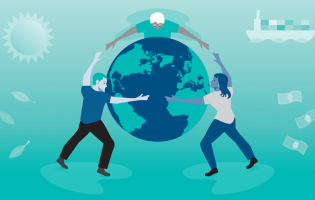
Official White House Photo by D. Myles Cullen via Flickr
COVID-19 and Trade: Not the End of Globalization but Changes in Value Chains to be Expected

Anna Kantrup
Federation of German Industries (BDI)
Anna Kantrup is Senior Manager at the Federation of German Industries (BDI) in the Department for External Economic Policy. Here, she is responsible for the topics trade defense instruments, customs and questions related to the EU-UK negotiations of a free trade agreement, such as rules of origin or customs facilitation. She also manages the BDI Working Group Customs and Trade Defense Instruments. She holds a bachelor’s degree in Political Science and English-Speaking Cultures from the University of Bremen and a master’s degree in North American Studies from Freie Universität Berlin.

Christoph Sprich
Federation of German Industries (BDI)
Dr. Christoph Sprich is Senior Manager at Federation of German Industries (BDI) in the Department for External Economic Policy. Responsible for questions of globalization, international competitiveness, foreign direct investment and international CSR issues. Editor of BDI Focus Global Trade & Investment, management of the BDI Working Group Foreign Trade and Investment Policy and Vice Chair of the Business at OECD (BIAC) Committee on Investment and Responsible Business Conduct.

Nikolas Kessels
Federation of German Industries (BDI)
Dr. Nikolas Kessels is a Senior Manager at the Federation of German Industries (BDI) in the External Economic Policy Division.

Stormy-Annika Mildner
Executive Director, The Aspen Institute Germany
Stormy-Annika Mildner is the executive director at the Aspen Institute Germany and a Geoeconomics Non-Resident Senior Fellow at AICGS. She was Sherpa of the Business 20 (B20), the official Engagement Partner of the German G20 Presidency and Head of the External Economic Policy Department at the Federation of German Industries (BDI).
The economic impact of the COVID-19 pandemic is massive. In Germany and Europe, but also worldwide, a large number of companies had to shut down production. Most shops and cultural institutions had to close. This led to a substantial collapse in economic performance. International value and supply chains were interrupted, international markets collapsed.
It is therefore not surprising that the International Monetary Fund (IMF) in its latest World Economic Outlook of mid-April 2020 forecasted the global economy to shrink by 3 percent in the current year. As recently as January, the IMF had still estimated global GDP growth of 3.3 percent for this year. Should the corona pandemic lessen in the course of 2020, the IMF expects a partial recovery of the global economy in 2021.
The forecasts for world trade are also gloomy. The World Trade Organization (WTO) expects a decline in merchandise trade between 13 and 32 percent this year, depending on the length of the containment phases in the major economies. In addition to production losses, national export restrictions are increasingly disrupting trade. Just-in-time production has become impossible in the current situation. Stocks are being built up where there had previously been few or no stocks at all. Companies have to increasingly restrict their activities, especially in logistics. But it is not just trade that is negatively affected. Foreign direct investments, another main driver of globalization, are also hurt by COVID-19. In the wake of the pandemic, UNCTAD estimates that global FDI flows will drop by up to 40 percent in 2020.
Due to the asymmetrical course of the crisis as well as recoveries, global trade and global investment flows are likely to recuperate only slowly. In contrast to the recent financial and economic crisis of 2008-2011, it cannot be expected that emerging and developing countries will pull export-oriented countries, such as Germany, out of the crisis. After all, they too are suffering massively from the pandemic.
The Changing Landscape of Global Value Chains
The internationalization of global value chains has been losing momentum for quite a while. A variety of factors is responsible for this—some bad, such as rising protectionism, and some good, such as digitalization.
The ratio of trade in goods to world GDP serves as a simple indicator, since the former largely consists of trade in intermediate products (according to the WTO, about two-thirds of world trade takes place within global value chains). Between 1970 and 1990, the ratio rose moderately from 27 to 39 percent and then steeply to 61 percent in 2008. Since then, the trend has been stagnant; in 2018 it stood at only 59 percent.
This is caused by economic developments, such as the relative increase in less trade-intensive services, compared to classic value added by manufacturing in GDP. Another positive and rather welcome economic trend is the increasing digitalization of industrial production. In many industries, new technologies, such as 3D printing or selective laser melting (SLM), promote the relocation of production steps.
Another factor is technological advancement in major emerging markets. China, in particular, is becoming more technologically independent and is increasingly producing high-tech inputs itself rather than importing them.
Three separate markets seem to be emerging: a U.S.-centered, an EU-centered, and a China-centered market.
However, there are also economically damaging developments behind the re-regionalization and re-localization—and these have political roots. According to WTO data, at least 1,594 new trade-restrictive measures (such as tariff increases or import bans) were adopted by WTO members between October 2008 and May 2019. With the election of U.S. president Donald Trump, the creeping protectionism, which could be observed since the last financial and economic crisis in 2008-2011, has gained considerable momentum. The geopolitical rivalry between the United States and China fuels re-localization and re-regionalization. Three separate markets seem to be emerging: a U.S.-centered, an EU-centered, and a China-centered market.
Protectionism in the Corona Crisis
The coronavirus crisis is not the end of globalization, but companies are carefully analyzing their supply chains for vulnerabilities. To boost resilience, just-in-time production will be reviewed; companies will build in more redundancies to be prepared for future crises and will diversify their supply sources. During the crisis, many states are promoting domestic production of essential goods. Many of the national economic stimulus packages create incentives for domestic production. In some countries, such incentives are reinforced by “buy-national” clauses in public procurement.
So far, there is no centralized registration of the new trade barriers. The WTO has set up a website compiling relevant information for international trade in times of the corona crisis. However, due to often incomplete notifications of new measures, the WTO information is also insufficient. According to the WTO, by late April 2020, 33 countries and the European Union have notified 92 trade and trade-related measures (including export restrictions and bans, exceptional and temporary criteria, suspension of compulsory certification, trade facilitation) to the WTO (as of April 24, 2020). Of these, twelve measures were temporary export bans (Egypt, Albania, Australia, Kyrgyzstan, Northern Macedonia, South Korea, and Thailand) and three measures indicated temporary implementation of export licensing requirements (Costa Rica, European Union, and Ukraine).
The actual number of export restrictions is likely to be much higher, however, as some countries, such as the United States and India, have not yet notified their export restrictions to the WTO. The organization’s Secretariat estimates that as of April 22, 2020, “[…] 80 countries and separate customs territories have […] introduced export prohibitions or restrictions as a result of the COVID-19 pandemic, including 46 WTO members (72 if the EU member states are counted individually) and eight non-WTO members.” According to the WTO, most of the restrictions target items listed by the World Customs Organization (WCO) as relevant in fighting the pandemic (COVID-19 test-kits, personal protective equipment, thermometers, disinfectants, medical devices, medical consumables, and soap). However, 17 countries have also restricted the export of foodstuffs.
Regrettably, the EU, which is otherwise a champion of open markets, is one of the countries that imposed export restrictions. With its implementing regulation 2020/402, the EU made the export of personal protective equipment (PPE) subject to authorization until the end of April. This means that exports from the EU are prohibited unless a license is obtained. The granting of such licenses is limited to exceptional circumstances that require extensive checks. Shortly after, the EU revised its regulation (Implementing Regulation 2020/426) and issued guidelines thereby effectively lifting the restrictions for EFTA. However, the restrictions on exports to other third countries remained in place. In mid-April, the Commission announced that further adjustment would be made so that from April 26, 2020, export licenses would have to be obtained for protective masks only. However, this has not materialized. With Regulation EU 2020/568, the EU continues to control the export of protective eyewear and visors, mouth-nose protection equipment, and protective garments. Furthermore, the Commission will monitor national licensing authorities. While the attempt at streamlining European licensing procedures is laudable, the consultation obligation is likely to cause further delays and, hence, constitutes another bureaucratic hurdle chipping away at one of the most precious resources available in the pandemic: time.
The United States has also imposed export restrictions. On April 3, 2020, the White House published an executive order instructing the Federal Emergency Management Agency (FEMA), an agency belonging to the Department of Homeland Security, to ensure the availability of respiratory filters, face masks, protective gloves, and respirators in consultation with the Department of Health and Human Services. A temporary final rule by FEMA was published in the Federal Register on April 10, 2020. The above-mentioned medical goods may not be exported without a FEMA-permit (subject to approval). FEMA’s temporary final rule exempted only shipments for existing contracts that were concluded through January 1, 2020. As a sufficient condition, it added that qualifying companies must establish that 80 percent of annual production preceding the contract had been reserved for the U.S. market.
On April 21, 2020, FEMA published a list of further exemptions effective April 17. The list contains ten additional categories that serve as clarifications as to what is covered by FEMA’s export restrictions. For example, shipments to U.S. territories like Guam, to U.S. military installations outside the United States, or diplomatic shipments are explicitly outside of the scope of the temporary final rule. Furthermore, FEMA makes clear that export restrictions should neither interfere with the international commitments of the United States nor disrupt supply chains vital to U.S. economic interests. Consequently, FEMA exempts shipments to non-governmental organizations, permits intra-company transfers to company-owned and affiliated foreign facilities, and authorizes shipments of covered materials in transit through the United States.
China also strictly controls exports. Since April 1, 2020, all exports of medical products including COVID-19 testing kits, medical face masks, medical protective suits, ventilators, and infrared thermometers must be accompanied by proof of registration with the National Medical Products Administration (NMPA). The export controls were most likely not triggered by concerns about a possible shortage in China, but rather by deficiencies in the quality of some Chinese products. In Spain, for example, there had been complaints about the failure of Chinese virus test kits. Nonetheless, the measures have led to considerable international tensions, particularly vis-à-vis the United States.
In addition to export controls, distortions in global value chains and production networks are caused by the distinction “essential” and “non-essential” branches of production and services in numerous countries. In some countries, for example, exporters must provide evidence that exported goods will be used in systemically relevant production branches/products in the buyer country. Such a certification obligation (e.g., for plastic granulate, screws, and cables, which are also urgently required for the manufacture of respiratory equipment) causes a worldwide patchwork of different definitions and regulations. The resulting legal chaos, combined with considerable opaqueness, leads to enormous legal uncertainty for companies and a massive amount of bureaucracy, which further hampers trade.
Export restrictions come with considerable risks.
Export restrictions come with considerable risks. This is the conclusion of a study by the Peterson Institute for International Economics, as well. For example, the EU’s export restrictions could actually worsen the EU’s supply of medical goods: Although a large proportion of medical devices and innovative medicines are manufactured in the EU, the EU is dependent on imports of products for medical care, especially for generic drugs, protective equipment, and pharmaceutical raw materials: in 2019, the EU imported PPE products worth $17.6 billion. If other countries, such as China, imposed similar export restrictions, the EU would be worse off than it would be with open markets.
Furthermore, in many industrial production processes, for example, in clean room environments, PPE is a necessary component. This is especially true for the production of drugs and medical equipment. Important production sites of the (European) chemical and pharmaceutical industry are located outside Europe—in particular in the United States, China, Brazil, Indonesia, South Africa, Canada, Mexico, and Russia. If international production networks were interrupted, the EU would also feel supply shortages.
All over the world, manufacturers are working tirelessly to expand and convert their production capacities to produce the goods needed to cope with the health crisis. In this herculean task they must be able to rely on unbureaucratic processes and internationally open markets. This applies both to the raw materials and components required for further processing (input side) and the delivery to markets abroad (output side). Any additional restrictions can delay this necessary conversion by weeks—if not months.
Recommendations for Global Trade
Open markets are key! The G20 countries should therefore quickly agree not to erect new barriers to trade in necessary protective gear and medical goods and to dismantle existing barriers. This is the only way to ensure that these goods are available where they are most needed. The WTO should keep a close watch on new trade measures taken by the G20 countries and make them public as quickly as possible. Transparency is key for functioning value chains.
Instead of protectionism, a policy is needed that secures and strengthens global supply chains for protective gear and medical goods.
Instead of protectionism, a policy is needed that secures and strengthens global supply chains for protective gear and medical goods. As long as there is no corresponding agreement among WTO members or the G20, the EU should lead by example and at least exempt all countries that have not imposed export restrictions from EU export restrictions. An agreement should be reached with countries that have imposed export restrictions to mutually lift them.
Countries that have defined systemically important industries and services (also called essential) should refrain from requesting certificates from importing countries on the use of these goods. New bureaucratic hurdles must be dismantled. Legal certainty is indispensable in trade.
Furthermore, the G20 countries should agree to eliminate customs duties on pharmaceutical products and intermediate products as well as medical products in an unbureaucratic, comprehensive, and lasting manner. This would facilitate the fight against global health emergencies and pandemics and reduce the burden on national health systems and companies. A pragmatic approach should be taken that avoids costly customs procedures as well as excessively narrow product coverage, which could lead to unjustified disadvantages and distortions in the supply chain. The tariff reductions should be bound under the WTO and apply on a multilateral basis.
During the crisis, measures to stabilize trade such as facilitating access to trade finance and insurance are highly welcome. Given the increased risks in trade, many countries have already extended guarantees both given time frames and country coverage. At the same time, a close monitoring of these measures internationally is necessary as they could also entail an unlevel playing field. Again, coordination is key.
International coordination is also essential to prevent further shortages of key supplies and medical goods. Accordingly, the G20 should establish a forum with representatives from governments, multilateral organizations, non-governmental organizations and industry. This could serve as a clearing house for transparent and critical information on the status, problems and solutions of the global supply chain. The forum could also advise governments, based on scientific and ethical principles, on how to allocate and use critical goods effectively and efficiently to meet the challenges of COVID-19.
Finally, the G-20 countries should agree on measures to support industry in converting production capacities to goods that are now urgently needed. Capacities must be expanded worldwide, international cooperation and investment in the production and research of protective and medical goods must be strengthened. This would increase resilience in the medium- and long-term and effectively protect states and their peoples.
The coronavirus crisis shows that the WTO is more needed than ever! Thus, it is high time for members to work constructively towards WTO reform. In particular, the blockage of the dispute settlement mechanism needs to be overcome to ensure that trade conflicts are settled in a transparent, timely, and just manner.








